If you are planning to purchase a new pick and place machine for your manufacturing unit, here are a few insights from experts that could help you select the best machine for your specific requirement.
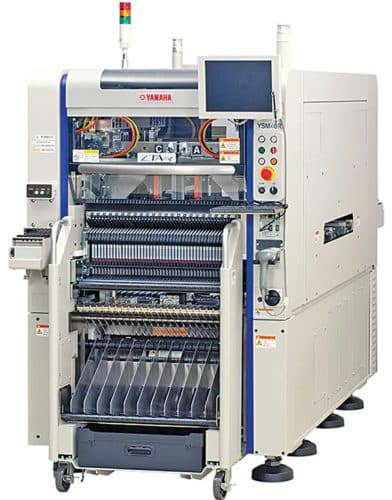
A pick and place (PnP) machine makes use of comprehensive mechanisms to mount small electronic components and SMDs, such as capacitors, resistors, and ICs, onto a printed circuit board (PCB). It ensures that the small components are picked up carefully and placed accurately onto the PCB. The machine can be manual requiring placement by hand, semi-automatic with software assistance for placing, or automatic for typical mass manufacturing units with in-line facilities. Combined with their respective strengths, here are a few parameters to consider before investing in the machine.
The PnP machines have considerably improved recently to achieve speed with accuracy, and flexibility. However, standard requirements for specific parameters, like accuracy rate, component sizes, and board sizes, have not changed much. The future of SMT production is anything but predictable according to experts. With rapidly changing build schedules, there is a proliferation of new materials and advanced components to locate, load, mount, and trace. As these high-mix challenges go mainstream and mid-volume, real productivity and throughput suffer. Several equipment manufacturing firms are trying to solve precisely these challenges.
Let us have a look at some of the features and the challenges so that you can select the most appropriate machine for your production house.
Machine construction
When selecting a PnP machine, the most important factor is its construction. It determines the machine’s effective components per hour (CPH) number, footprint, and the number of component feeders it can accommodate. The construction may either be all-welded steel or a bolted-together frame.
The most accurate machine may come with a welded structure to provide significant stability for accurate positioning and high-speed movement in X and Y axes. This suits any production environment without need for calibration. Apart from this, careful selection of centering methods and component positioning systems can support optimisation.
Placement speed
CPH is the measure at which the machine will pick up and place components onto the PCB. The speed measured in CPH will have a direct impact on production volume. Many PnP machine manufacturers rate their machines based on the IPC 9850 standard, a general guide for part mix and PCB placement arrays of their machines. It helps determine the throughput after accounting for feeder changes, transfer time, and other adjustments along the entire assembly process.
The industry is working towards faster machines every year to match the increased speed demand. Yamaha Motor’s ultra-high-speed modular Z:TA-R YSM40R is one of the recent launches claiming to offer 200,000 CPH. The speed is said to be achieved by edge technology, including innovative high-speed rotary heads and linear motors incorporating new, high-speed algorithms, with the machine width of just one metre.
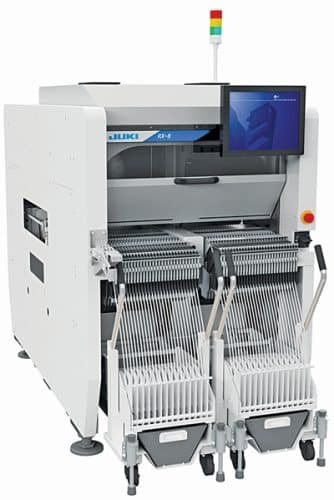
Juki Corp’s RX-8 is another recent launch that claims to have the highest placement rate per square metre with CPH up to 100,000. It is compact and modular, featuring 998mm width. The new P20 placement head, designed for placing ultra-small chips and small integrated circuits (ICs), is credited for high-speed picking and placing from the single reel.
Intelligent camera systems
A camera system with high resolution improves the overall speed of the machine. New machines focus on their camera systems, like the one in the Neoden 8 PnP machine. It comes with the HR Flyvision camera system for component recognition and Double Mark cameras to reach the extreme end feeders for better calibration.
Component handling
The PnP machines handle the minimum and maximum component dimensions according to the production needs for chip-scale package (CSP), ball-grid array (BGA), and other odd parts. The machines need various alignment methods to handle such a range of components, say, from minimum sizes of 0402, 0201, or 01005. Tiny components smaller than 0402 may require additional nozzles. The machines with single alignment give more precision and speed. An alternative alignment system can handle large component sizes.
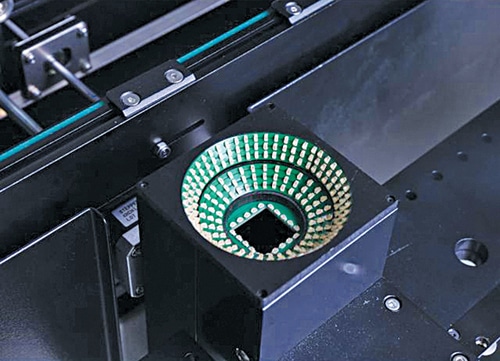
However, one should remember, not all machines that can handle large components can also inspect them. Hence, most of the new launches with the latest vision system and software can take on everything from 01005-size flip chips and CSPs to large quad flat packages (QFPs) and ball grid arrays (BGAs). Even tall, odd-shaped and through-hole components can be mounted with ease.
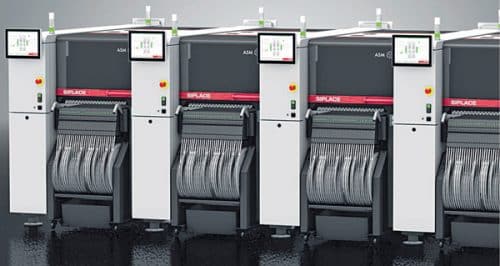
For instance, ASM Assembly Systems has a complete solution from component pickup, image recognition to placement of odd-shaped components. Its Siplace TX models are said to work with up to 48,000 CPH with minimum 0201 (metric) and maximum component size of 8.2mm×8.2mm×4mm.
Number of pick up heads
A PnP machine has single or multi-heads to grab different shapes and heavy parts. Equipped with a number of nozzles to grasp the components, the head is movable in different directions simultaneously to ensure high productivity and flexibility.
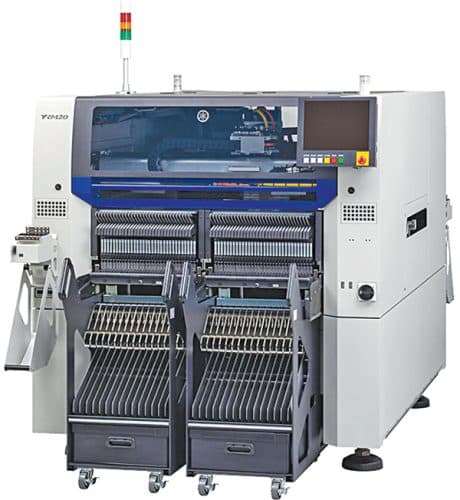
For instance, the Yamaha YRM20 comes with a rotary RM head that is claimed to achieve 115,000 CPH. It features a one-head solution that can carry components of odd shapes and eliminates the need for head replacements, thus improving the component feed speed.
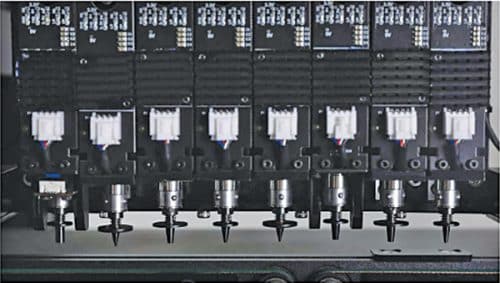
Similarly, the Neoden 8 model has eight synchronised nozzle heads to give repeatable placement accuracy.
Smart feeders
Recent machines focus also on the feeder capacity. The larger components may require larger feeders. So, it is advisable to figure out the number of slots needed for larger tape feeder types, say, from 4mm to 56mm.
Mycronic MY300 has an ‘intelligent feeder’ solution that is claimed to take less than ten seconds of loading time. Agilis tape and stick feeders and tray handling systems in the machine are said to handle a wide range of components to meet the needs of today’s SMT manufacturing grounds. The compact 4, 8, 12, and 16mm Agilis tape feeders come with an innovative cover-tape separator on the pen-sized feeder that exposes components for easy picking. The feeders provide quantity and location tracking, operator guidance, simplified data entry, moisture sensitive device (MSD) handling, and on-the-fly changeovers. Fully operator-independent, it ensures higher productivity in a smaller footprint. Its product set-up time is another important feature for quick processing.
With the SMT measuring feeder feature in place, there is no need to measure materials manually, which improves the efficiency and avoids the occurrence of material error. The recent machines feature component verification before placement to ensure the right component is placed at the right location and comes with RCDT (resistor, capacitor, diode, and transistor) measurement tools. Neoden 8 features pneumatic feeders.
Component lead pitch
Industry experts consider 0.012 fine pitch as an unsaid thumb rule for selecting PnP machines. The component lead pitch is the distance between the centres of the leads. However, experts warn buyers to not be moved by motor specifications or accuracy as even machines with great motor accuracy may not pick up, inspect, and place fine-pitch components.
Smart bin system
The most common reason for unplanned downtime in high-mix electronics manufacturing is missing material. A smart bin system helps machine operators minimise downtime by ensuring that all needed material is collected and prepared just-in-time for production. Building on other powerful material handling solutions, the system brings ease-of-use to the kitting and changeover process. The end result is faster changeovers and higher utilisation.
Next-generation precision
The latest pick-and-place solutions combine rigid machine frame, advanced mount head technology, and automatic thermal adaption for the highest levels of precision. The MY300 adds an improved line scan vision system to take this accuracy into the next generation. It combines three programmable light sources with either 2K or 4K resolution to ensure a future-proof solution for the most advanced components down to 0.15mm pitch. Both options provide extremely precise on-the-fly positioning and inspection for any type of miniaturised or specialised component
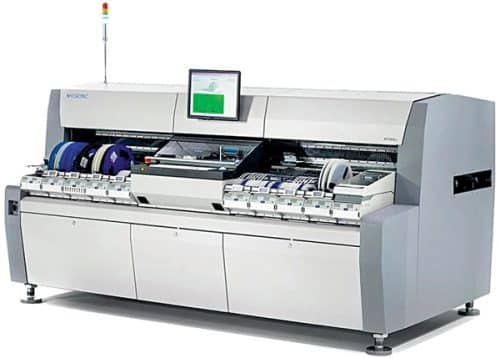
Accuracy and repeatability
Experts’ candid recommendation regarding accuracy for PnP machines is 0.00254mm (0.0001-inch) with a fine pitch lead of 12mil repeatedly. Though such high accuracy is commonly characterised for high-budget machines, one can always find a used PnP machine to attain such results. Besides, remember to buy a machine that comes with software suites to handle the process.

Featuring a single turret head with eight or twelve nozzles, Europlacer’s ii A1 model is said to deliver flexibility in handling a broad range of components with 164 feeder positions and two internal matrix trays, all in a compact footprint. It also features the firm’s patented intelligent conveyor with board stops under full software control.
Software suite
If you are considering purchasing automatic machines, how are they programmed and what are the software used should be answered. The software has three primary goals of easy use, flexibility, and optimising performance.
Whatever, remember to check if your model comes with a computer or just the software. This can neither be good nor bad as some users prefer to install the software on their own PCs. A fully integrated system is the best choice to avoid software compatibility issues, however.
Also check if the machine runs on a familiar graphical user interface (GUI), such as Windows, or a proprietary system. Most operators prefer a standard GUI since a proprietary GUI may require a longer learning curve. CAD download, teaching camera, barcode readers, management information system (MIS), and optimisation functions and off-line programming can all make the operator’s job easy and efficient. Hence, a strong software suite is important to make the process easy and traceable.
For instance, DDM Novastar adds a unique programming software—SMTrue Run Optimise—to the full-scale SMT assembly services it offers. The software is used for making offline programming of automatic SMT machines to derive increased efficiency and throughput.
ASM Assembly System also has IIoT interfaces for integration into line and factory systems (ASM OIB, IPC-Hermes 9852, IPC-CFX) and the cloud (ADAMOS) with advanced workflow solutions for setup processes, material management, factory monitoring, and factory integration.
The new machines are also using a lot of open source software. OpenPnP is an open source SMT pick and place system that includes ready-to-run software and hardware designs that you can build and modify. Index PnP is an open source pick-and-place machine that is among the recent launches designed for mass-production volumes typical of crowdfunding projects.
Other important considerations
Populating more boards and machines that are fit for any intelligent factory, complete with fully automated material flow, faster changeovers and open interface software is the real pursuit of the industry. There is no limit to the minutiae of pick-and-place machine specifications. You may have to select the features as per your needs.
Unlike the rapid placers, precision placers often do not use mounted nozzles. They may rely on gantry-supported moving heads with relatively few pickup nozzles. While the conventional four-head vertical heads were only available in table-top machines, now they have evolved into automated machines.
Some machines may have to optionally be fitted with a dispense head for depositing adhesive on the board. If you require this feature, consider the dispense method, dot size, and dispense speed.
Maximum and minimum PCB or panel size and thickness can be critical requirements for some manufacturers. Fiducial recognition, coordinate correction, and bad mark detection should be standard for any automatic PnP machine.
New machines have a 3D stereo measurement feature for the through-hole device that easily identifies the image of the vertical pin and height of the component lead to detect bending deformation. This tells whether the through-hole components are placed accurately to ensure the correct height after placement, and thus reduces the need for operator’s visual inspection. Similarly, pattern feature recognition is another aspect intended for special components to recognise irregular placements and ensure accuracy.
Experts also try to find the best acceleration. In many cases, the acceleration of large components is set manually. Recent upgraded machines can automatically detect and accelerate to ensure the quality of placement and maximise the utilisation of equipment.
The next idea catching up is of PCB placement inspection. Before valuable components, such as BGAs and land-grid array (LGAs), are placed, interfering object detection is carried out in the placement area below these components. The foreign material/parts in excess are found in time to avoid placement defects. This can check whether there are any missing components under the shields before they are placed, which may play a good protective role in improving product quality.
The automotive electronics industry is expected to increase the demand for SMT continuously. Considering that automotive products have higher requirements for personal safety, service life, and outdoor use conditions, the reliability and durability needs of automotive electronic products are higher than those of others.
New PnP machines feature technologies like auto-cut sensor and advanced sensor technologies. Auto-cut sensor technology is a human safety feature that temporarily stops the process to avoid serious hazards or machine damage on human intervention. Advanced sensor technology helps a specific set of sensors, like in-sensor, out-sensor, and waiting sensor, in tracking the PCB at every stage in the production process.
Auto-optimisation is another feature to consider as it can suggest feeder and nozzle measurements. There is also a feature called regular automatic detection for nozzles. The closed-loop control of the nozzle ensures that the nozzles on the placement head are always in a normal clean condition, and the contaminated and damaged nozzles are automatically replaced in time.
Choosing the best
The latest generation of the placement machines sets new records in speed, floorspace performance, and accuracy for high-volume production applications. Smart factory solutions are fast becoming a trend in the electronics manufacturing industry to cut down on costs and improve efficiency of production.
However, buyers should pay attention to performance and usability in relevance to their manufacturing needs. Machines are available in various price ranges with a wide range of customer support and maintenance. Keeping in mind the investment on machine is vital to avoid spending a fortune on costly outsourced machines.
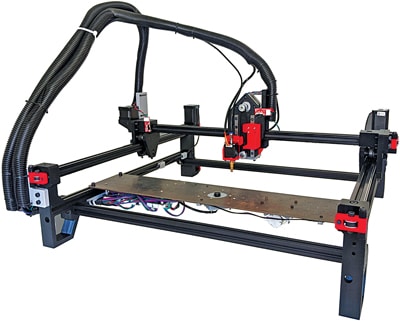
While the classic PnP vision systems are difficult to work in areas requiring production tolerances and deviations, Schubert Group—a company developing modular packaging machines—suggests its neuronal networks based on artificial intelligence could be a solution of the future. “The image processing system therefore learns on its own and sorts the products into classes independently in a longer learning process. This means that the parameters are selected by the system and no longer by the programmer. For customers, this means a significant step towards independence—In the future, they could actually use neuronal networks, under certain conditions, to teach their packaging machine to handle a new product on its own,” writes Dr Abdelmalek Nasraoui on the company website.
Abbinaya Kuzhanthaivel is a technophile at EFY with an interest to write on electronics, communication networks, and open source





